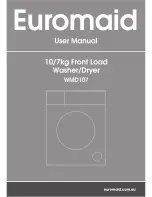
End-of-Cycle
(on some models).
The signal
operates with any cycle.
Variable Signal
The
always be used when drying
The control can be set anywhere
between OFF and LOUD, depending
polyester knits or permanent press items which should
on the desired sound level. The signal
will sound just before the end of the
cycle to remind you to remove the clothes.
be removed as soon as the dryer stops to help prevent
setting of wrinkles.
The signal should also be used with the
Extra Care Cycle.
To stop the signal while sounding, turn the signal
control to OFF or advance the Cycle Selector to OFF.
Polyester Knits & Permanent Press Drying Tips
●
DO NOT
●
REMOVE CLOTHES
●
PLACE ON
Garments being dried or
PROMPTLY—To help prevent
Permanent press and polyester
should tumble freely.
wrinkling, remove clothes from
knit garments look best if placed
the dryer promptly at the end of
on hangers after drying.
the drying cycles.
The Difference Between Automatic and Timed Drying
Automatic Drying (Electronic)
Automatic Drying
Timed Drying
(on some models)
When using the Automatic Cycles,
When using the Timed Cycles, you
When using the Automatic Cycles,
the
Control system
select the number of minutes you
the
continually senses the temperature
wish the dryer to run and it turns
system continually senses the
of the air in the dryer drum. Wet
off at the end of this time period.
moisture in the tumbling clothes,
laundry keeps this air cool. When
determines when they are dried to
laundry is dry enough (and the
your pre-selected setting, and
drum air warm enough) the heat
terminates the cycle automatically.
turns off. When the air cools, the
Refer to the Controls Setting Guide
heat turns back on. This off and on
for recommended settings. The
cycling may happen number of
Cycle Selector will not advance
times (depending on the fabric, load
until clothes have reached a certain
size and Cycle Selector setting).
degree of dryness.
The Cycle Selector advances (when
the heat is
until it automatically
turns off the dryer.
Drying Selections Guide for the Automatic Cycles
Set to NORMAL Position
●
For most normal loads.
Set toward More Dry
Set toward Less Dry
●
For loads that include heavy-
●
For
weight fabric loads.
weight fabrics.
●
If you desire to remove less
●
If you desire to remove
moisture.
more moisture.
●
For very small loads.
7


































